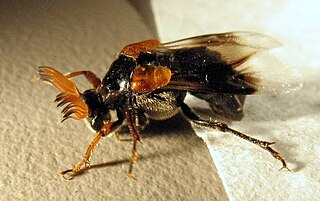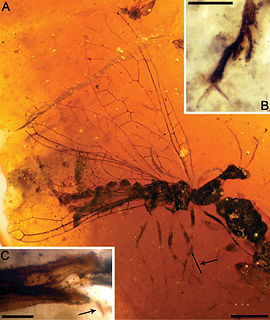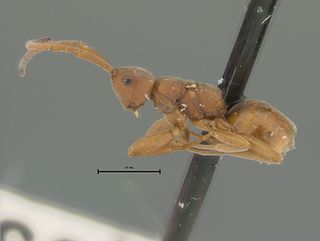
The Cupedidae are a small family of beetles, notable for the square pattern of "windows" on their elytra, which give the family their common name of reticulated beetles.

Ripiphoridae is a cosmopolitan family of some 450 described species of beetles sometimes called "wedge-shaped beetles". Ripiphoridae are unusual among beetle families in that many species are hypermetamorphic parasitoids, an attribute that they share with the Meloidae. Members of the family differ in their choice of hosts, but most attack various species of bees or wasps, while some others attack cockroaches.

The Evaniidae, also known as the ensign wasps, nightshade wasps or hatchet wasps, are a family of parasitic wasps. They number around 20 extant genera containing over 400 described species, and are found all over the world except in the polar regions. The larvae of these solitary wasps feed on cockroaches, and develop inside the egg-cases (oothecae) of their hosts.

Archaeidae, also known as assassin spiders and pelican spiders, is a spider family with about ninety described species in five genera. It contains small spiders, ranging from 2 to 8 millimetres long, that prey exclusively on other spiders. They are unusual in that they have "necks", ranging from long and slender to short and fat. The name "pelican spider" refers to these elongated jaws and necks used to catch their prey. Living species of Archaeidae occur in South Africa, Madagascar and Australia, with the sister family Mecysmaucheniidae occurring in southern South America and New Zealand.

The Berothidae are a family of winged insects of the order Neuroptera. They are known commonly as the beaded lacewings. The family was first named by Anton Handlirsch in 1906.

Apsilocephalidae is a family of flies in the superfamily Asiloidea. The family was proposed in 1991 as a close relative of Therevidae distinguishable by genitalic characters. The family contains three extant genera and four extinct genera described from the fossil record..

Kateretidae is a family of short-winged flower beetles in the suborder Polyphaga. There are about 11 genera and at least 40 described species in Kateretidae. They are found worldwide except in New Zealand. Adults are anthophagous, feeding on flowers, while the larvae are spermatophagous inside the flower corolla.

Hemiphlebiidae is a family of damselflies, it contains only one extant species, the ancient greenling, native to Southern Australia and Tasmania. The fossil record of the group extends back to the Late Jurassic.

Omma is a genus of beetles in the family Ommatidae. Omma is an example of a living fossil. The oldest species known, O. liassicum, lived during the final stage of the Triassic (Rhaetian), over 200 million years ago, followed by several other species from Europe and Asia until after O. attenuatum from the Lower Cretaceous, the genus then reappears in the Burmese amber during the Cenomanian, then disappears from the fossil record for the remaining 100 million years until today, with one species endemic to Australia, three other extant species that were formerly part of this genus were moved to the separate genus Beutelius in 2020. The extant Omma stanleyi is strongly associated with wood, being found under Eucalyptus bark and exhibiting thanatosis when disturbed. Its larval stage and many other life details are unknown due to its rarity. Males are typically 14-20 mm in length, while females are 14.4-27.5 mm. Omma stanleyi occurs throughout eastern Australia from Victoria to Central Queensland.

Mesoraphidiidae is an extinct family of snakeflies in the suborder Raphidiomorpha. The family lived from the Late Jurassic through the Late Cretaceous and is known from twenty-five genera. Mesoraphidiids have been found as both compression fossils and as inclusions in amber. The family was first proposed in 1925 by the Russian paleoentomologist Andrey Vasilyevich Martynov based on Upper Jurassic fossils recovered in Kazakhstan. The family was expanded in 2002 by the synonymizing of several other proposed snakefly families. The family was divided into three subfamilies and one tribe in a 2011 paper, further clarifying the relationships of the included genera.

Embolemidae is a small family of around 64 species and 3 genera distributed around the world. They are small solitary parasitoid wasps, and are parasites on planthopper nymphs of the families Achilidae and Cixiidae.
Parvaverrucosidae is an extinct insect family in the aphid superfamily (Aphidoidea), of the order Hemiptera. It contains the monotypic genus and species Parvaverrucosa annulata known from the Cenomanian aged Burmese amber of Myanmar. First described in 2005, the genus was redescribed in 2019, which found it to be in the superfamily Palaeoaphidoidea
Ellinaphididae is an extinct family of aphids in the order Hemiptera. There are about 13 genera and more than 40 described species in Ellinaphididae.
Szelegiewicziidae is an extinct family of aphids in the order Hemiptera. There are about 6 genera and 10 described species in Szelegiewicziidae.
Umenocoleidae is an extinct family of dictyopteran insects known from the Cretaceous. The family was originally considered to be part of Coleoptera. They are considered to be closely related to the Alienopteridae within the superfamily Umenocoleoidea. Some species possess complex, cryptic colouration similar to those of the earliest flowers. A more recent analysis places Alienopteridae and Umenocoleidae as sister taxa within Dictyoptera, and not within Blattodea.

Mimarachnidae is an extinct family of planthoppers known from the Cretaceous period. Their name is derived from spots on the wings of the first described genera, Mimarachne and Saltissus, being suggestive of spider mimicry, but these characters are not distinctive for the family as a whole. The family is characterised by "simplified venation and setigerous metatibial pecten and hind leg amature". as well as "rounded anterior margin of pronotum, double carination of pronotum and mesonotum"
Perforissidae is an extinct family of planthoppers. They are considered to belong to the group of "Cixiidae-like" planthoppers. Species are known from the Early to Late Cretaceous of Eurasia, North America and South America. The family was named by Shcherbakov in 2007

Zhangsolvidae is an extinct family of brachyceran flies known from the Cretaceous period. Members of the family possess a long proboscis, varying in length between 1.3 and 7 mm depending on the species, and were probably nectarivores. A specimen has been found with preserved Bennettitales pollen, suggesting that they acted as pollinators for extinct gymnosperms.
Rhagionemestriidae is an extinct family of brachyceran flies known from the Jurassic and Cretaceous periods. It was first named as a subfamily of the Nemestrinidae by Ussatchov (1968), and was raised to full family status by Nagatomi and Yang (1998). They are considered to be closely related to the family Acroceridae. Similar to Acroceridae, members of the family possess a large hemispherical head, with eyes covering nearly all of the area.

Elcanidae are an extinct family of Mesozoic and early Cenozoic ensiferans. Members of the family are distinguished by the presence of spurs on the distal part of the metatibia, unique among orthopterans, these have been suggested to have been used for controlling gliding or as swimming aids. They are known from the Late Triassic to Paleocene of Eurasia, North and South America.













